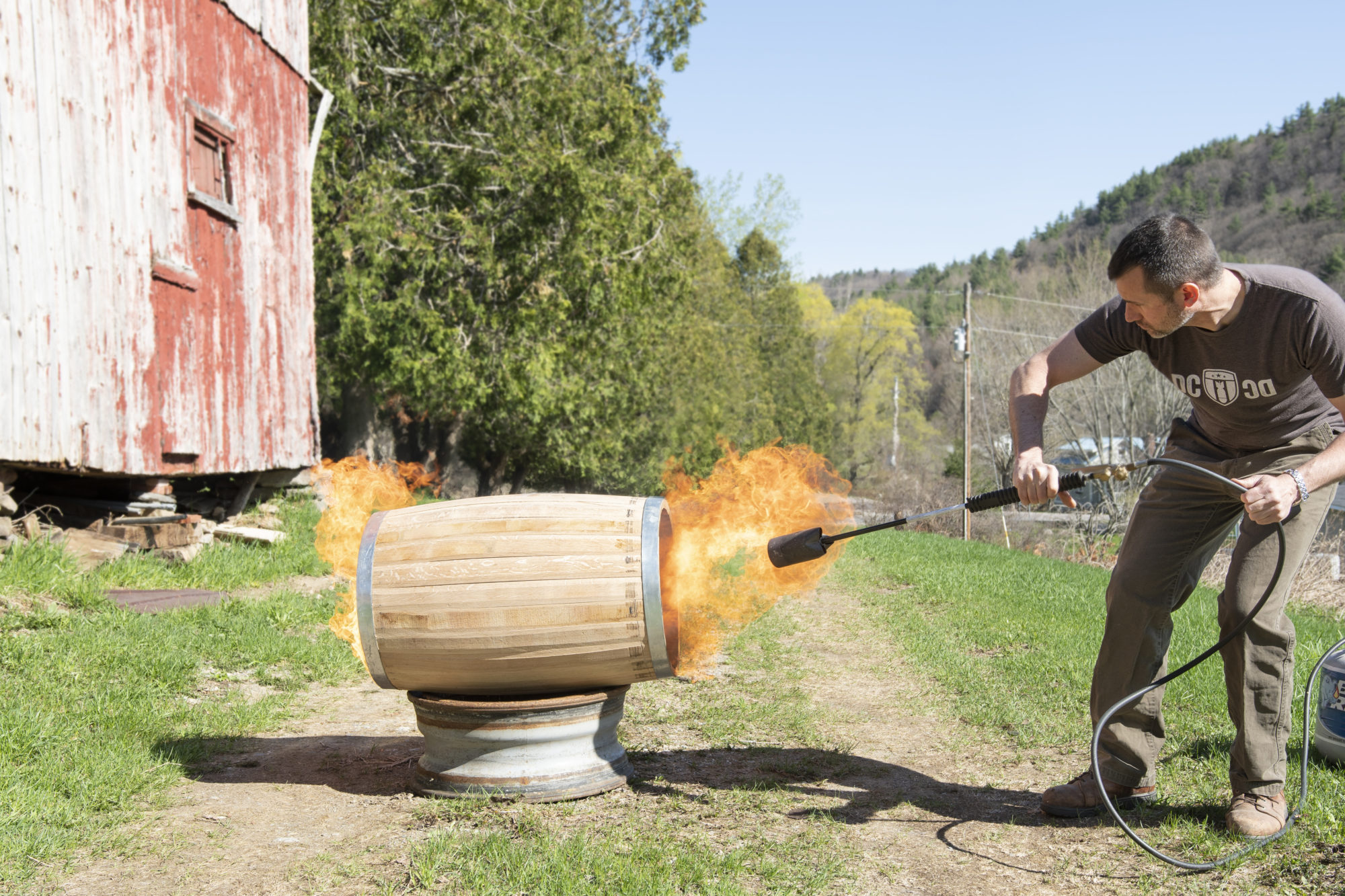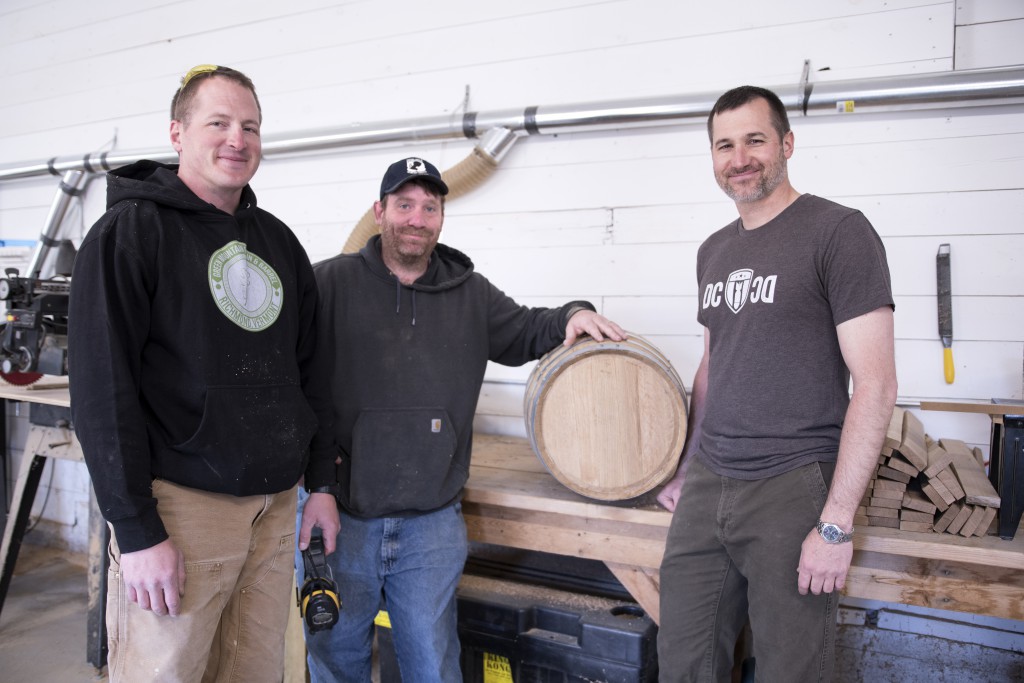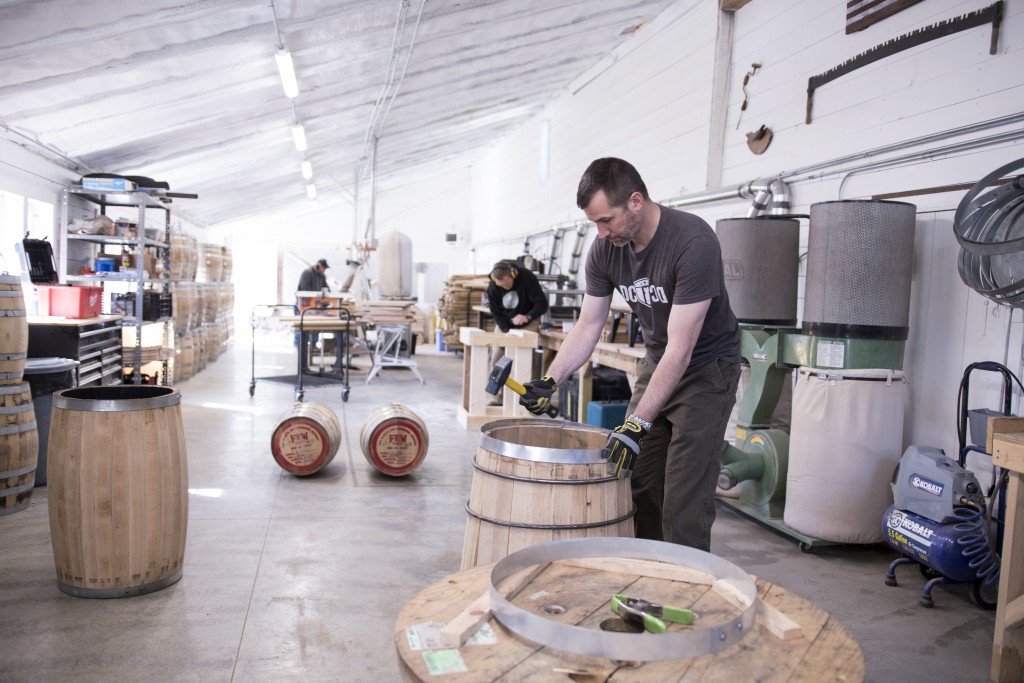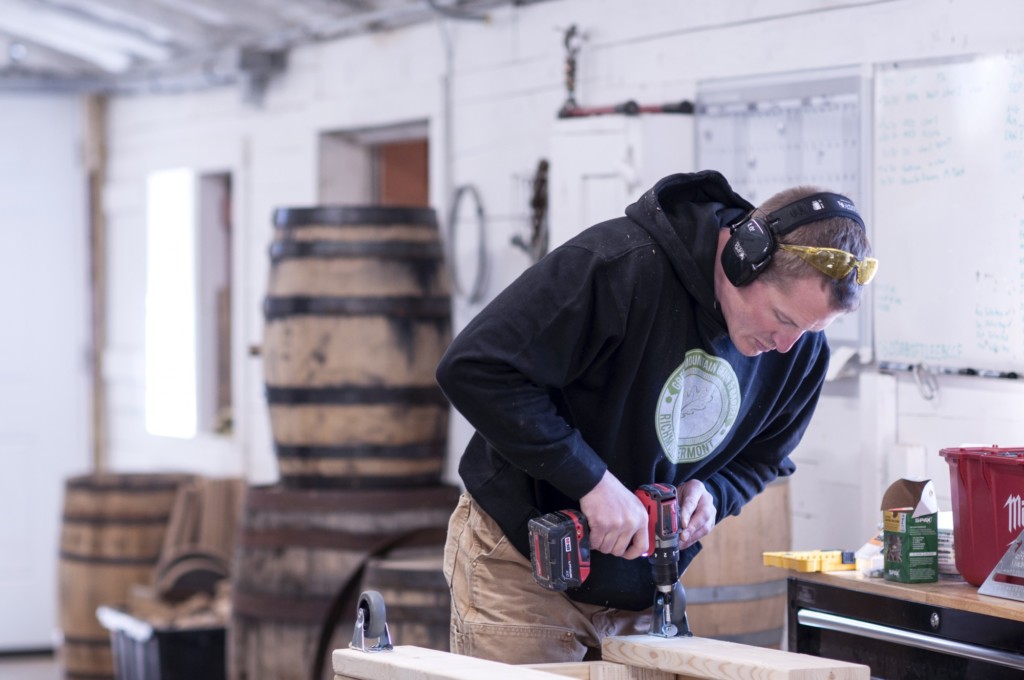Cooperage Finds Niche in Vermont Craft Spirits Industry
May 13, 2018

By Christine McGowan, Forest Program Director, Vermont Sustainable Jobs Fund
Green Mountain Grain & Barrel producing locally-sourced, locally-made oak barrels.
Woodworkers by hobby and Vermont National Guardsmen by training, Tony Fletcher, Josh Waterhouse and Mac Broich are finding their niche as coopers for Vermont’s craft spirits industry. Green Mountain Grain & Barrel was founded in 2016 with a simple goal: to be the sole producer of barrels for Vermont distilleries, wineries and breweries.
With the number of Vermont distilleries increasing from three in 2004 to 28 in 2018, according to the Vermont Department of Liquor Control, Green Mountain Grain & Barrel is betting on increased demand for locally-made barrels. “We learned from our friends at Danger Close Craft Distilling that sourcing barrels for craft production was a challenge,” said Fletcher. “The big distillers use big, mass production cooperages out of Kentucky or Missouri, but the smaller guys who only wanted five or ten barrels were out of luck. They either had to buy 200 barrels that they didn’t need, or try to pool resources with other craft distilleries.”

Woodworkers by hobby and Vermont National Guardsmen by training, Mac Broich, left, Josh Waterhouse, center, and Tony Fletcher, right, are finding their niche as coopers for Vermont’s craft spirits industry. Photo Credit: Erica Houskeeper
The Vermont forest connection
Armed with an idea, passion for working with wood, and appreciation for Vermont’s growing craft distillery industry, the trio began making barrels– a labor intensive and meticulous process. The first step was sourcing white oak logs, widely considered the standard for use in barrels, buckets and ships due to a substance called tyloses that makes the wood naturally waterproof. “It’s important to us that our wood comes from Vermont,” said Fletcher. “White oak trees that have slowly grown to maturity through the harsh Vermont winters produce wood with tight grains and a dense cell structure, plus that local connection is a big part of our story.”
White oak, however, makes up less than one percent of the state’s annual hardwood harvest, and finding logs suitable for staves (free of knots and branches) is challenging. Green Mountain Grain & Barrel partnered with Canopy Timber Alternatives in Middlebury and Northeast Timber Exchange in Castleton to purchase the white oak logs required for making barrels. “We can confidently say that 80 to 100 percent of our wood is harvested within Vermont,” said Fletcher.

Tony Fletcher taps the top hoop, also known as the chime hoop, on the barrel after he has raised it. Raising is the process of arranging the hoops in a circle around the assembly hoops. Photo Credit: Erica Houskeeper
Building a better barrel
Next up, production. “We went around to all the big guys in Vermont,” said Fletcher, “and asked them if they would buy Vermont-made barrels if we could make them at the same quality and price. It was a resounding yes!” With initial orders from Danger Close, Mad River, and Silo Distilleries, the trio set to work bending, toasting and charring the wood to the exact specifications of their new customers. “We are the opposite of mass production,” said Fletcher, “sometimes all three of us are working on one barrel at the same time.”
It’s a delicate process that begins with bending the wood into a barrel over an open fire and securing it with metal hoops. This step, known as toasting, also softens tannins and caramelizes sugar in the wood. From there, the barrel moves on to the charring stage, where the entire interior of the barrel is set on fire for a specific period of time. “Working with open fire was terrifying at first,” laughed Fletcher. “We weren’t sure if we were going to burn all that hard work into a pile of ash. But getting the toasting and charring just right is what allows the liquid inside to transform from something harsh into something smooth and palatable.”
Without any mentors or models for their business, Green Mountain Grain & Barrel relied on trial and error to perfect their craft. “The big guys don’t want to share their trade secrets,” said Fletcher, “so we had to improvise and problem solve along the way.” They received support earlier this spring from the Vermont Agency of Agriculture, Food & Markets in the form of a $50,000 grant from the Working Lands Enterprise Initiative, which they used to upgrade tools and equipment that will allow them to increase production. That trial and error process also led them to offer reconditioning of used barrels. “We can take used barrels, scrape them down to the original wood, and re-toast or char them at a fraction of the cost of a new barrel,” said Fletcher. “We’ve gotten pretty good at repairing leaks.”

Mac Broich attaches casters to a cart he just built that will make it easier to “rejuvenate” used barrels. Photo Credit: Erica Houskeeper
Keeping it local
While all of the barrels sold to date are still aging at distilleries, Fletcher expects the first batch to come out sometime this summer or early fall from Mad River Distillery. Danger Close, Silo and Old Route 2, a new distillery in Barre, will all have releases coming out soon as well. “Our customer is the producer who cares about using Vermont products in an authentic way– not only to support marketing but also to support the local economy and supply chain, starting with the logger who pulls the tree out of the woods.” Though the company has sold one barrel to a brewer in Massachusetts, their intention is to saturate the Vermont market before moving further afield. “Our goal is to make all of the barrels that Vermont can handle,” said Fletcher.
Vermont Forest Industry Network
Vermont’s forest products industry generates an annual economic output of $1.5 billion and supports 10,000 jobs in forestry, logging, processing, specialty woodworking, construction and wood heating. The new Vermont Forest Industry Network creates the space for industry professionals from across the entire supply chain and trade association partners throughout the state to build stronger relationships and collaboration throughout the industry, including helping to promote new and existing markets for Vermont wood products, from high quality furniture to construction material to thermal biomass products such as chips and pellets. Learn more or join at www.vsjf.org.
Feature photo above: Tony Fletcher chars a barrel, which means the entire interior of the barrel is set on fire for a specific period of time. Photo Credit: Erica Houskeeper




